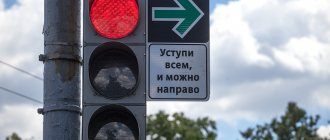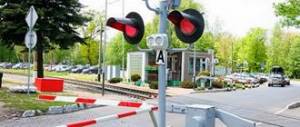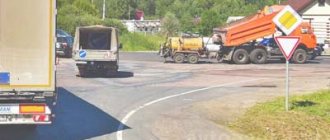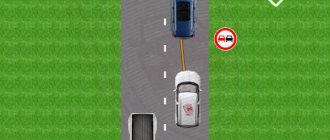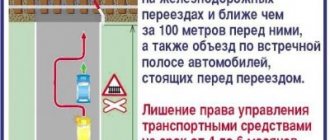On modern city roads you rarely see a traffic police inspector. Traffic control is mainly carried out by traffic lights. That is why paragraph 7 of the traffic rules is quickly forgotten and when meeting an inspector, many drivers are seized with a slight panic, fraught with unpleasant consequences in the form of an accident. This article will present traffic controller signals in pictures with explanations.
When crossing an intersection that is regulated by an inspector, you should pay attention to the position of the body, hands and additional gestures with a baton, prohibiting or allowing movement in a certain direction. Signs by a traffic controller can be given either with a classic striped rod or a disk with a reflector, or simply with his hands. As an additional attraction of attention, a sound signal with a whistle is used.
Important! The traffic controller has priority over all other coordination signals - traffic lights, signs, etc.
Who is a traffic controller and why is he needed?
A traffic controller is a policeman or military man who is entrusted with the responsibility of controlling traffic using symbols. To prevent drivers and pedestrians from being tempted to ignore him, the guard is dressed in a special uniform/equipment. There should be an insignia on his clothes that tells him that this person is worth obeying for his own safety.
Although most drivers believe that the police always regulate traffic, in fact this responsibility can be taken on by traffic police officers, road services, railway crossing attendants and other officials. The only thing that is required of them is knowledge of the signaling system, understanding of traffic and the ability to quickly deal with any situation.
Traffic controller signals
It is worth learning by heart, because this person appears on the road when there is a traffic jam or other problems arise. Of course, we are used to obeying traffic lights, but sometimes they fail. For example, during a power outage, all traffic lights within a block may go out. How do motorists behave in such cases? The most daring pretend that they are moving along the “green corridor”. Others try to let pedestrians and cars pass from the main road. This creates confusion, and the guard is called upon to eliminate it.
Specially trained people with a baton and a whistle appear on the roads after major accidents to prevent chaos and traffic jams.
How do traffic lights and traffic controller signals
? Who to believe if there is a traffic light at an intersection, but a person in uniform gives completely different signs? It's simple: the guard has priority - even before priority signs. Other road signs remain valid. Moreover, an official can sometimes direct drivers even under prohibitory markings, don’t let this bother you. If a guard urges you to ignore some signs, it means that an accident has occurred, repair work is underway, or the streets have been blocked in honor of a holiday. The guards are not fined for following the instructions.
At the most important intersections for urban traffic, a special person can be placed even when the traffic lights are working and there are no traffic jams. This is done for double control, so that there is someone able to visually assess the situation.
Features of driving through an intersection with a traffic controller
Usually in driving schools they don’t talk about the fact that an intersection with a traffic controller is one of the most dangerous places on the road. And the point here is not even that drivers try to run over the traffic controller himself, although such cases occur quite often.
So, two main problems:
- Any car from any direction can go at any time. Many drivers still do not know the signals of the traffic controller, so they can contribute to the occurrence of an accident.
- The traffic controller may give a signal that is not in the traffic rules. This situation is more complicated. In practice, I had to see a traffic controller who stood with his left (not right) arm extended forward. In the described situation, I recommend staying in front of the intersection and waiting for a more appropriate gesture.
Table for memorizing traffic controller signs
| Signals and gestures | |||||
| Face or back | Sideways, arms down or outstretched | Facing the driver, gesture points to the car | Right hand raised | Sideways, wand on the right side | |
| Cars, trucks, motorcycles | You can't move, slow down | You can move | Right turn allowed | Movement Prohibition | You can't move, stop |
| Trams | Let's start moving straight | ||||
| Pedestrians | Passing in front of or behind the guard is allowed | You can only cross behind the traffic controller's back. | |||
Prohibiting gestures
Traffic warning signs
There is a correspondence between traffic light signals and gestures made by the traffic controller; the most common traffic rules will be indicated in pictures and with explanations.
If the traffic controller has his face or back turned to the driver, and his arms are lowered, spread to the sides, or his right hand with a baton is raised in front of his chest, and his left is lowered down, then driving through the intersection in any direction is prohibited.
A traffic controller's signal prohibiting movement with a comment, in the picture the position means a red traffic light
The traffic controller is located sideways to the car, on the right side. Movement is prohibited, despite possible instructions from the wand.
The traffic controller's prohibitory signal, in the picture the inspector is turned to the driver's right side
Movement from the rear is completely prohibited, despite the position of the rod forward in the direction of the vehicle.
Traffic prohibition, corresponds to a red traffic light in the traffic rules, the traffic controller in the picture has his back turned to the driver
Interesting! Drivers will find a useful saying to help them remember the basic prohibitions: “The chest and back are a wall.”
Movement is prohibited regardless of the traffic controller's gestures
Traffic controller gestures in pictures with explanations
The traffic controller raised his hand up
If the traffic controller raised his right hand up, what
this
means
? The command implies that there is no need to pay attention to traffic lights and road signs. Instead, stop and wait for further instructions. In this case, it does not matter whether the traffic controller is facing you or with his back to you. But if you do not have time to complete the maneuver, no problem: complete and stop, this will not be a violation.
A raised hand can be considered a kind of analogue of a yellow traffic light.
If the traffic controller has his hands down
This is the position of the traffic controller's hands
prohibits movement towards him behind his back. Only those drivers in relation to whom he is standing sideways drive straight and to the right. Moreover, the command also applies to pedestrians; they can only cross the road parallel to the guard.
Right arm extended forward
This is the position of a traffic controller on the road
can be interpreted differently, depending on how the car is positioned in relation to the person. If he has his arm outstretched and his face is turned in your direction, you can only go to the right. If the traffic controller is facing you with his right side or back, you are prohibited from driving. Another thing is if he is standing with his left side towards you, you can move in any direction. Look, the logic here is this: the guard shows the corner that you cannot cross.
Additional traffic controller gestures
- Rotate the baton in front of the chest: Drivers on the right and left should speed up. Drive fast!
- A sharp downward movement of the hand and an indication to the left: complete the turn to the right.
- Signal to stop when you are already at the intersection: complete the movement while the traffic controller is looking at you.
Why are gestures on the road so important?
What do traffic controller signals mean?
How to remember the traffic controller's signals A memory verse about the traffic controller. The traffic controller can with full confidence be called a “living” traffic light, the symbols of which must be understood and followed by all traffic participants at the intersection! Exactly, exactly, this person is signaling not only to drivers, but also to pedestrians. Depending on the position of his arms and body, it is either allowed or prohibited to move in one direction or another.
An integral attribute of the work of such a specialist is a rod or disk with a reflector or a red signal, which are necessary to improve visibility. With their help, he gives prohibiting or permissive conventional signs. Regardless of whether the traffic controller has a rod in his hands or not, you are obliged to follow his signals!
Gestures of traffic controllers may be accompanied by an additional whistle
This focuses the attention of any person participating in traffic on the change in his position
Traffic controller signs for pedestrians
Every driver is a pedestrian, but not every pedestrian is a driver. Traffic controller gestures
affect you not only when you are driving. In order not to create confusion on the roads, remember the instructions for pedestrians:
- Arms spread out to the sides. In this case, the hands indicate the direction of movement. Cars should let people through, especially since most often such signals are given at pedestrian crossings.
- The hand is raised up, the other can be extended forward. Pedestrians are not allowed to move; we are waiting for the traffic controller to clear the crossing. Before this, he will definitely stop the traffic flow, so you can’t go wrong.
Traffic rules about traffic controller signals
Traffic controller signals are described in detail in paragraph 6.10 of the traffic rules. This explains all the signals and actions that a driver must take when displaying certain signs. The rules are written very dryly and formally, and not every driver will be able to understand them the first time. Therefore, many motorists use original ways to remember them. Traffic controllers’ gestures can be divided into 3 categories:
- permissive;
- prohibiting;
- warning.
All of them apply under certain conditions.
Traffic controller gestures in verse: how to easily remember traffic rules
There are general rules that allow you to quickly understand the sign system. No matter how unusual they may look at first, everything is logical and simple. Thus, an outstretched rod or hand sets the direction of movement, but drivers cannot move behind the traffic controller’s back. But drivers can turn right, while the same electric vehicle moves only along the direction given by the inspector.
However, it’s easy to get confused on the road, especially when a guard suddenly appears in sight. Therefore, it is useful to remember simple verses that will tell you what the signals mean:
The stick is pointed upward - it tells everyone to stand.
If the stick looks
in
your mouth, make a right turn
.
If the rod points to the right, you have no right to ride.
If the stick points to the left, drive like a queen
.
An unclosed back is a wall for the driver!
Although such poems sound childish and even funny, they are great for helping you remember how to act. The absurdity plays into the hands, because this way the instructions are better etched in the memory. By the way, similar sayings exist for pedestrians, for example: “I’m standing facing you - be patient, be good.”
Permissive gestures
The rules provide for only 3 enabling signals:
- The arms remain down and pressed to the body or extended in different directions, while the traffic controller stands sideways. This signal allows trams to go straight ahead and other vehicles to go straight or to the right. If traffic is not determined by lanes, then you can turn to the right only if you are in the right lane.
- The traffic controller turned his left shoulder to the flow, and extended the rod to the left. This gesture allows movement in all directions, even left turns and turns. The signal allows trams to turn left.
- The traffic controller's hand extends the baton into the drivers' faces. This gesture only allows you to turn to the right. The traffic controller can also tell drivers which way to go by extending their left arm. This signal is equal to the green arrow at the traffic light, allowing movement.
What is the priority of the traffic controller?
Clause 6.15 of the Rules states that traffic controller signs are more important than road signs.
Any road users must fully comply with the signs given by the traffic police inspector, even if they completely contradict the traffic lights and other signs.
As a result, if a traffic light malfunctions, but there is a traffic controller, you only need to follow the instructions of the second one. Traffic police officers understand the problem of the majority of motorists who do not know traffic controller signs, so they use informal gestures that are understandable to all drivers.
Traffic rules of the Republic of Belarus Chapter 7. Signals of traffic lights and traffic controllers
Traffic regulations of the Republic of Belarus, chapter 7, paragraph 38: traffic regulation can be carried out by a traffic controller wearing a high-visibility uniform with elements of reflective material, clearly visible at any time of the day, having a rod or disk with a red signal or a reflector, a red flashlight or a flag.
Signals of the traffic controller of the Republic of Belarus Chapter 7:
- Traffic rules of the Republic of Belarus chapter 7 clause 38.1. arms extended to the sides or lowered: from the left and right sides it is allowed: for the tram - to move straight, for other vehicles - straight and to the right, for pedestrians - to cross the roadway; from the chest and back: the movement of all vehicles and pedestrians is prohibited;
Signals from traffic controllers Traffic regulations of the Republic of Belarus
Traffic regulations of the Republic of Belarus chapter 7 clause 38.2. the right arm is extended forward: from the left side it is allowed: for the tram - to move to the left, for other vehicles - in all directions; from the chest: all vehicles are allowed to move only to the right; from the right side and back: the movement of all vehicles is prohibited; pedestrians are allowed to cross the road behind the traffic controller;- Traffic rules of the Republic of Belarus chapter 7 clause 38.3. hand raised up: the movement of all vehicles and pedestrians is prohibited in all directions, except as provided for in paragraph 43 of these Rules. The traffic controller can give hand gestures and other signals that are understandable to road users;
- Traffic regulations of the Republic of Belarus, chapter 7, paragraph 39: the traffic controller’s requirement to stop the vehicle is expressed by giving a signal with a hand gesture, a baton (a disk with a red signal or a reflector, a red lantern or a flag) or using a loud-speaking device. The driver must stop at the place indicated to him;
- Traffic rules of the Republic of Belarus chapter 7 paragraph 40; an additional whistle signal is given to attract the attention of road users;
- Traffic regulations of the Republic of Belarus, chapter 7, paragraph 44: signals and instructions of the traffic controller are mandatory for road users, even if they do not comply with the requirements of traffic lights and other technical means of traffic management.
